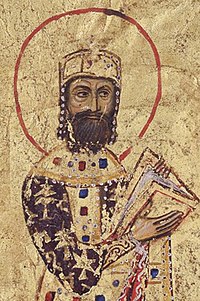George Palaiologos
George Palaiologos | |
|---|---|
| Native name | Γεώργιος Παλαιολόγος |
| Allegiance | Byzantine Empire |
| Years of service | c. 1078–c. 1097 |
| Rank | sebastos |
| Battles/wars | Battle of Dyrrhachium, Battle of Dristra, Battle of Levounion, First Crusade |
| Spouse(s) | Anna Doukaina |
| Children | Nikephoros, Andronikos, Michael, Alexios |
| Relations | Nikephoros Palaiologos (father), Alexios I Komnenos (brother-in-law) |
George Palaiologos or Palaeologus (
Life
Early life and career
George Palaiologos was the son of the first known member of the
George Palaiologos is first mentioned in 1078, alongside his father, who was serving as the governor of the Theme of Mesopotamia at the time; the two supported the rise to the throne of Emperor Nikephoros III Botaneiates (r. 1078–1081), although his father had been a Doukas loyalist.[3][6] In 1080, Palaiologos participated in a campaign against the rebel general Nikephoros Melissenos. Along with his cousin, Basil Kourtikes, he was placed under the command of the incompetent court eunuch John, who refused to follow Palaiologos' advice. Soon, however, John became frightened of the constant attacks of the Turks, and left the army in Palaiologos' hands. Although the latter managed to save the army from disaster, John complained about him at court, and on his return to Constantinople Palaiologos was prohibited from entering the imperial palace.[3][7]
Role in the Komnenian coup

Although related to the
When the Komnenian army marched on Constantinople, Palaiologos was put in charge of negotiating with the German commander Gilpract, who commanded the garrison at the
At the same time, when the Komnenoi and some of their partisans, now sure of their victory, contemplated sidelining the
Palaiologos' father had remained loyal to Botaneiates, and their meeting in Constantinople after the coup is described by Skoulatos as one of the "most passionate" scenes of the Alexiad, the great historical biography written by Alexios Komnenos' daughter Anna Komnene.[16]
Military career under Alexios
Soon after the Komnenian coup, Palaiologos was tasked by Alexios with defending the city of
In October or November 1083, Palaiologos led the Byzantine army that recaptured
In 1094 Palaiologos, with the rank of
Likely his last mention was a visit to the hermit saint Cyril Phileotes, shortly before the latter's death in December 1110.[21][23] George Palaiologos died sometime between 1118 and 1136.[21][23]
Legacy
George Palaiologos was the chief source used by Anna Komnene in her Alexiad on her father's battles, and is very favourably portrayed by her in her book as both capable and loyal.[23][24] The Alexiad is in turn the main source about Palaiologos' life.[23] Anna's positive assessment is also shared by her husband, the general and historian Nikephoros Bryennios the Younger, who calls Palaiologos a "brave warrior, of high military ability".[23]
Family
George Palaiologos had a younger brother, Nicholas.[25] Through his marriage to Anna Doukaina, George had four sons:[25]
- Nikephoros, paternal ancestor of the Palaiologos dynastythat became the Empire's ruling dynasty after 1261.
- Andronikos, doux of Thessalonica.
- Michael, a sebastos, married a daughter of Theodore Dasiotes
- Alexios, married Anna Komnene Doukaina and became a maternal ancestor of the Palaiologos dynasty
References
- ^ Kazhdan 1991, p. 1557.
- ^ Skoulatos 1980, p. 99.
- ^ a b c Gautier 1971, p. 233.
- ^ Angold 1997, pp. 104–105.
- ^ Skoulatos 1980, pp. 99–100.
- ^ Skoulatos 1980, pp. 100, 245.
- ^ a b c Skoulatos 1980, p. 100.
- ^ a b c d e f g Gautier 1971, p. 234.
- ^ Angold 1997, p. 126.
- ^ Skoulatos 1980, pp. 100–101.
- ^ Gautier 1971, pp. 223, 234.
- ^ Skoulatos 1980, pp. 101, 126.
- ^ Skoulatos 1980, p. 101.
- ^ a b Skoulatos 1980, pp. 101–102.
- ^ Angold 1997, pp. 127–128.
- ^ Skoulatos 1980, pp. 245–246.
- ^ a b Skoulatos 1980, p. 102.
- ^ Skoulatos 1980, pp. 102–103.
- ^ a b c Skoulatos 1980, p. 103.
- ^ Gautier 1971, pp. 234–235.
- ^ a b c d e f Gautier 1971, p. 235.
- ^ Skoulatos 1980, pp. 103–104.
- ^ a b c d e f Skoulatos 1980, p. 104.
- ^ Birkenmeier 2002, pp. 3, 63–64, 76.
- ^ a b Kazhdan 1991, p. 1558.
Bibliography
- ISBN 0-582-29468-1.
- Birkenmeier, John W. (2002). The Development of the Komnenian Army: 1081–1180. Brill. ISBN 90-04-11710-5.
- Gautier, Paul (1971). "Le synode des Blachernes (fin 1094). Etude prosopographique". Revue des études byzantines (in French). 29: 213–284. .
- ISBN 0-19-504652-8.
- Skoulatos, Basile (1980). Les personnages byzantins de l'Alexiade: Analyse prosopographique et synthèse [The Byzantine Personalities of the Alexiad: Prosopographical Analysis and Synthesis] (in French). Louvain-la-Neuve and Louvain: Bureau du Recueil Collège Érasme and Éditions Nauwelaerts. OCLC 8468871.
Further reading
- Dawes, Elizabeth A., ed. (1928), The Alexiad, London: Routledge & Kegan Paul
